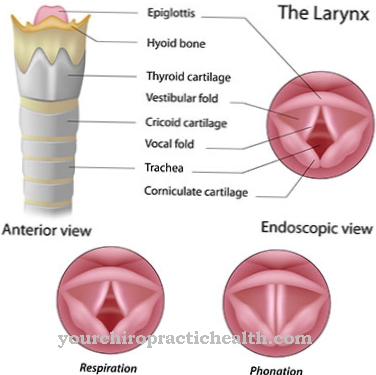Lagophthalmos is the term for incomplete eyelid closure. Sometimes the symptom leads to the widening of the eyelid.
What is lagophthalmos?

© Oleg Gekman - stock.adobe.com
Under a Lagophthalmos an incomplete closure of the eyelid is understood. The symptoms fall into the field of ophthalmology and neurology. In some cases, lagophthalmos can widen the eyelid gap.
The term lagophthalmus comes from the Greek and means “rabbit eye” in German. So Lagos means "rabbit" while ophthalmos means "eye". In most cases, lagophthalmos only appears in one eye. But it can also appear on both eyes.
From a distance of three millimeters and in combination with a strong lacrimal gland hyposecretion there is a risk of keratitis (corneal inflammation) without appropriate therapy. In the worst case, there is a risk of ulceration (ulcer formation) and loss of the affected eye.
causes
The causes of lagophthalmos are different. The most common cause of the eye disease is peripheral paralysis of the facial nerve, which forms the 7th cranial nerve. In medicine, facial nerve palsy is used. This affects the orbicularis oculi eye muscle, which has the shape of a ring. A stroke can be the possible cause of the paresis.
In some cases, lagophthalmos is also caused by scars that shorten the eyelids. The same applies to the deformation of the affected eyelid due to traumatic damage. Sometimes the protrusion of the eyeball (exophthalmos) is responsible for lagophthalmos.
Other possible causes of lagophthalmos are ectropion (malposition of the eye), congenital malformations such as a coloboma, endocrine orbitopathy that occurs in Graves' disease, herpes zoster oticus, polyneuritis, meningitis, a cerebellar bridge angle tumor or the occurrence of a coma . In rare cases, leprosy on the eyelids also leads to what is known as a rabbit's eye.
Symptoms, ailments & signs
With lagophthalmos, the affected person feels as if they have a foreign body in their eye. In addition, there is a burning sensation in the eyes, which is often perceived as excruciating. In addition, the eye feels dry. The reason for this is the inability of the eye muscle to completely close the eye.
It is not uncommon for the cornea to dry out due to lagophthalmos, which doctors call xerophthalmia. There is a risk of the cornea becoming inflamed and causing an ulcer. If the patient tries to close the affected eye, Bell's phenomenon appears.
This is a temporary rotation of the eyeball in the upper direction. Because the blinking of the eyelids is also reduced with lagophthalmos, this leads to impediments to the drainage of tears and to tears. If there is a mild form of lagophthalmos, it can sometimes lead to a positive eyelash sign.
Diagnosis & course of disease
If lagophthalmos is suspected, it is recommended to consult an ophthalmologist and a neurologist. The neurologist clarifies whether the symptoms are caused by paralysis of the facial nerve. A thorough examination of the affected eye with a slit lamp takes place at the ophthalmologist.
During this procedure, the ophthalmologist checks the conjunctiva, the cornea and the inside of the eye for possible damage. With timely treatment, lagophthalmos takes a favorable course. Without appropriate therapy, however, there is a risk of complications such as a corneal ulcer. In the event of a very unfavorable course, the eye can even be lost.
Complications
In most cases, lagophthalmos leads to a relatively strong feeling of foreign bodies in the patient's eye. As a result, those affected often suffer from a burning sensation in the eye or from very dry eyes. The eye pain can also spread to other regions and continue to lead to headaches. The quality of life of the person affected is significantly reduced by the lagophthalmos.
Lagophthalmos can also lead to impaired concentration and coordination in the patient. The affected person's field of vision is not infrequently restricted and an ulcer can develop. Inflammation of the cornea can also occur, which must definitely be treated by a doctor. In most cases, lagophthalmos does not self-heal, so that a doctor must be consulted in any case.
Treatment of this disease in most cases is carried out with the help of various ointments and eye drops. There are no complications. In severe cases, however, surgical interventions or the use of antibiotics are necessary. There are no complications here either. The life expectancy of the patient is usually not reduced by lagophthalmos.
When should you go to the doctor?
If you feel a foreign body in the eye, you should consult a doctor to clarify the cause. If the eyelid cannot be closed completely, it is advisable to discuss this observation with a doctor. If small particles from the immediate vicinity keep getting into the eye despite a strong blink of the eye, a doctor's visit is required. If the eyes become dry or watery, a doctor should be consulted. Eye pain, itching, discomfort, and changes in vision should be evaluated and treated by a doctor. Eye muscle disorders are a warning that should be followed up.
If the symptoms cause rubbing of the eyes and redness as a result, the person concerned needs medical help. A doctor should be consulted if there is inflammation in the area of the eyes, irritation or internal restlessness. If the person concerned suffers from insomnia, headaches or swelling of the eye, a doctor should be consulted as soon as possible. Changes in blinking, ulcer formation, and discoloration of the retina should be investigated and treated immediately. If tear drainage is impaired or pus forms, a doctor is advised. Without medical care, those affected must expect an increase in symptoms.
Treatment & Therapy
The therapy of lagophthalmos depends on the extent of the damage to the cornea. Sufficient moistening of the surface of the eye plays an important role in the treatment of the disease. An eye ointment or eye gel can be used for this purpose. In some cases, a special watch glass bandage is used.
This is a transparent plexiglass flap with an adhesive plaster that covers it. The watch glass bandage protects the cornea from external influences and from drying out. Soft contact lenses are a further protective measure against drying out.
In reversible forms of lagophthalmos, the upper eyelid has also been loaded with lead weights since 1993. Due to their more efficient functional effect and their better cosmetics, they are superior to the watch glass bandage and ensure that the patient remains fit to drive. In addition, eye drops can still be applied.
If the conservative treatment methods do not lead to an improvement and the paralysis does not regress, an operation must be carried out. The same applies if there is major damage to the eye. As part of the operation, the upper and lower eyelids are partially closed. The patient is given a local anesthetic before the procedure. The row of eyelashes is usually retained with this procedure.
The procedure allows for surgical reopening. In the case of irreversible forms of lagophthalmos, a metal weight can be permanently implanted in the upper eyelid, which closes the eye. This is especially true after an acoustic neuroma or a parotid tumor.
This method was already used in the 1950s, but was then temporarily forgotten until it was used again in German eye clinics from 1990 onwards. If there is already an inflammation of the cornea (keratitis) or an ulcer, it is treated with antibiotics.
You can find your medication here
➔ Medicines for eye infectionsOutlook & forecast
The prognosis for lagophthalmos is favorable. Nevertheless, cooperation with a doctor is required, as there is no spontaneous healing and the possibilities for self-help are insufficient. Without treatment, an increase in symptoms can be expected. The field of vision is further restricted, paralysis increases in size and the eyesight is deteriorated overall. This increases the general risk of accidents in everyday life and the well-being of the person concerned is permanently reduced.
The various complaints are alleviated within a short time through the administration of medication. These are associated with few side effects, so that a good tolerance of the preparations is certified. In rare cases, surgery is required to improve the healing process. If this goes without further complications, after the wound healing process has been completed, the absence of symptoms can be documented.
The opening of the eyelids is surgically restored, thereby correcting the functionality of the eye. If injuries to the surrounding area occur during the procedure, the extent must be taken into account when making an overall prognosis. If pus forms in the area of the eye, the risk of sepsis is increased. This is a potential threat to human life. Intensive medical care is necessary, as otherwise you may die prematurely.
prevention
In order to prevent lagophthalmos, it is necessary to prevent the underlying diseases that cause it. However, this is not possible with facial paresis or malformation.
Aftercare
In most cases of lagophthalmos, the patient has few or no special follow-up measures available. The patient should consult a doctor early on so that there are no further complications and no further worsening of the symptoms. Self-healing cannot usually occur with lagophthalmos, so that the patient should ideally consult a doctor at the first symptoms and signs of the disease.
Usually the disease can be relieved well even with a minor surgical procedure. After such an operation, those affected should protect and care for their eyes particularly well. In general, stressful or physical activities should be avoided in order to avoid unnecessary stress on the body.
Contact lenses can also significantly alleviate the symptoms of lagophthalmos, so those affected should wear them if they have been prescribed by a doctor. If the lagophthalmos occurs as a result of a tumor, further regular examinations and controls should be carried out by a doctor after the tumor has been removed in order to prevent the tumor from spreading. Usually, however, this disease does not reduce the life expectancy of those affected.
You can do that yourself
Patients with lagophthalmos usually experience severe pain in the area of the affected eye. The most important self-help measure is therefore to take care of the eye and protect it from further stimuli. This can be achieved, for example, with the help of a sleep mask that the sick person can wear at night.
The doctor will also prescribe special eye ointments for the patient. These need to be applied regularly, and sometimes natural remedies can be added to them. After consulting your doctor, you can use arnica, for example, which relieves inflammation and pain.
In the event of an operation, rest and bed rest apply. The patient should not expose the eye to any additional stress after the procedure and also protect the body in order to reduce the risk of subsequent infections. In addition, the medically prescribed drugs must be taken. It is advisable to write down any side effects or interactions and inform the doctor about them. In this way, the medication can be optimally adjusted to the needs of the person concerned. In general, you should see a doctor regularly if you have pronounced lagophthalmos.



























